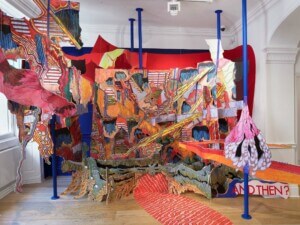London-based designer and film-maker, Keiichi Matsuda has finally realized what he thinks the future may look like. Augmented reality, twinned with the advent of digital developments such as Google glass, has made films like Minority Report and Blade Runner seem slightly less fantastical, and in Matsuda’s eyes, prescient in how physical and virtual worlds could one day merge.
His film, Hyper-Reality, imagines a future where technology and business visually dominate our lives. The film builds on his previous work Augmented Hyper-Reality Domestic Robocop (try saying that quickly) and Augmented City where the latter depicted technology altering how we view the city and urban environments. Both films were a success, making it into the MoMA and the Art Institute of Chicago.
Hyper-Reality is the convergence of these two films. “[It’s] much bigger and more ambitious,” said Matsuda. “It’s a more refined critique, and a fuller sense of place than the previous films.”
To begin with, the film plunges you into a suburban bus in Medellin, Colombia under the guise of Juliana Restrepo. At first this seems like an odd setting to host a sci-fi vision of the future though Matsuda explained how quickly the city is developing (it was the most innovative city of the year in 2013) and hence is a good stage to showcase how “rapid technological transformation” could change a city.
From the outset, Matsuda introduces darker themes of how interactive interfaces could render identity and existence easily disposable. However, the film’s take on how capitalism and technology alter our perception of space is its core idea.
Bamboozled by a kaleidoscopic splurge of information, Julianna Restrepo’s view of the world is saturated by adverts, warnings, snippets of health advice and media. The scenario feels like an extreme version of an inescapable Las Vegas or Times Square, with everything in our field of vision vying for our attention.
The film comes across as eerily realistic thanks the to inclusion of real life phenomena such as the Cootrasana bus service and Starbucks coffee. “Having real brands involved strengthens the films’ post-modern appeal, and it’s an ironic nod to the very systems that the film critiques,” said Matsuda.
“An inevitable consequence of the Internet mingling with the physical world, is that advertising and commercial environments would become an even bigger part of our cities,” he added. “I’m really intrigued as to how this would affect our experience, so I’m planning to create some innovative and visually arresting branded environments within the film.”
“I want to use the film as a platform for debate to anyone who is worried about where technology might be taking us,” Matsuda continued. “By creating more visions, and talking about them publicly, I believe that it’s possible to influence the people who are involved in developing these technologies in the first place.”
Thankfully, Matsuda’s hyper-realistic depiction of the future isn’t quite yet reality. While virtual reality machines are becoming an ever more popular tool for architectural purposes, the likes of Google glass and other similar products are yet to take off, mainly due to the products hefty price tag. Last year Google shelved their original eyewear piece though an updated product, Google Glass 2.0, is set to be unveiled, though will be marketed for healthcare and manufacturing purposes.










